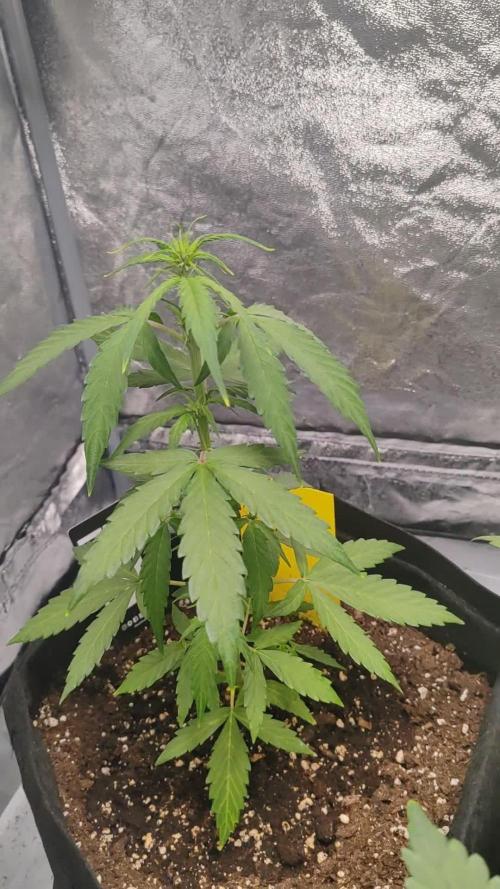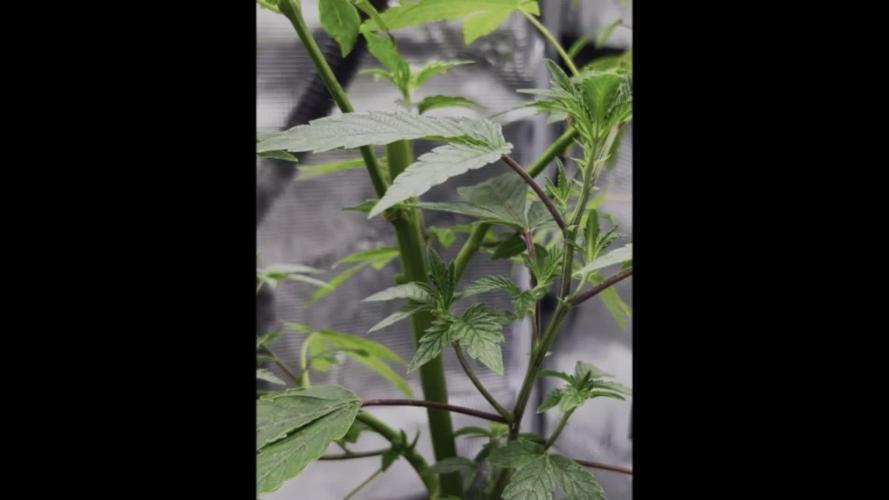The Grow Awards 2026 🏆 





































Likes
Comments
Share


@ConspiracyFly
Follow
Gorilla Glue Auto Day 89
This week I continue watering with 1.5 litres of water and nutrients every other day.
I continue to remove leaves that are obstructing the flowers.
The flowers continue to swell.
When I look through the magnifying glass the trichomes are some 50% clear, 50% cloudy, 0% amber.
Next week I will change the watering schedule and reduce the nutrients!?
Gorilla Glue #4 Week 10
Likes
19
Share


@valiotoro
Follow
Hello everyone 😎
Week 4 for my girl
She is doing very well,growing at fast pace and with a beautiful green colour on the leaves.
For the feeding schedule half grow half bloom + 1ml/L power buds
Have a nice day 😎
Likes
3
Share


@Bdawg
Follow
Think mighy av slight magnesium or calcium defiency on plant where i zoomed in on viseo.
Am feedin cana a&b.
And green sensation.
Stopped calmag last week
Likes
6
Share


@Moss420
Follow
Plants in the main tent are coming along well since correcting the light intensity and run-off ppm, the one on the left is filling out now, so is the one in the middle just much slower. Not sure if I will let that one cook longer or just pull it with the rest... will see how she looks in a week.
The plant on the right I spread out to take up almost half of the tent (I didn't want the spindler taking up unnecessary space) - her nugs are real nice - some foxtails and bleaching on the taller ones but for the most part looking good.
Plant on the left has filled out a lot more despite its weirder more "wiry" bud structure - does't look as nice as the good plants but definitely better than the spindly plant in the middle.
Big Mumma is still killing it - wondering if its getting close to flush time for her as it looks like some of her tricomes are starting to brown...
Likes
7
Share


@Hexus
Follow
Days 78-84 - Been lax in updates, but I still log every week to completion. Back injury in addition to The Nineteen, Rona Style, has been a bit of a pain in the posterior. (That means ass) Plants are gigantic and sassy. Had Dangergirl come out and defoliate/lollipop the bottoms out of the girls, saving me painful labor and increasing my yields, so yay for her! Plants are happy, pompoms are getting thick, and everything looks good. Switched FF01 to flower on day 84.
Likes
46
Share


@Rollex420
Follow
I am happy to announce a new beginning!
This time there will be new genetics and seed banks that I haven't tried so far, so I'm very curious to see how it will turns out!🤞🏻☺️
Also it will be the second round for my beloved Runtz Muffin that i promised to bring it back.😁
Now I just need to wait until these seeds will go for 18 hours in a glass with water and then I will transfer them to the paper towel to make them germinate properly and finalize the process in their pots once the sprout stretches by at least 2-3 cm. ☮️💚
Happy growing and positive vibes to everyone 🙌🏻💚
⚠️ 16-05-21 UPDATE ⚠️
Today i put these little girls into their 1L pots.
Now I will let them grow here for at least 10-12 days before transplant them into the final pot (11L)
..See ya at the next update!
Happy growing to everyone! ☮️💚
⚠️ 17-05-21 UPDATE ⚠️
So the first ones to break the soil and reach the light was the Mimosa, K-Mintz and the Meringue.
the Runtz Muffin is continuing to grow but still has not removed its seed from its head, which continues to be the slowest and still with a small sprout / root.. I'm sure that in the next few days it will be great together to her little sisters.
That’s all for today..😊
See ya next time fam ☮️💚
Likes
2
Share


@Madman2020
Follow
Vegetative steering
Aiming for:
leaf Temp -70f
CO2 300
VPD +.93
Planning for:
MJ and bras foilar
60%+1.5/-71f set to 68f+1.5
Leaf Temp is about 3f higher than ambient temp
At 68f outside, grow room still wont hit 68 with lights off
Day 24
No Co2
50-55klux
15inch from light
Leaf Temp 71-73f
60%/72F
Veg steering
Coconut water
Uneven canopy(11 at 29inch, 3ag 31 inch
————————
Day 26
56%68f(humidity dropped because i havnt watered in two days 🤡)
23inch-34inch tal. Arranged in order.
52-59klux
Sprayed
5Bras,(23inch)70 leaf temp
4Jas,(29inch) 70 leaf temp
4Bras&Jas(34inch)72f leaf temp
———————
Day 27
Watered once
————-
Day 28
Im pretty sure the sprays worked.
Noticed leaf burn with 3 plants sprayed with MJat 147ppm(.5ml)
No leaf burn with the .1Bras sprays
I wonder how long both are good for. Also, can i pour the unused spray in the medium? I just dont want to waste it.
Plants are noticeably more vigorous.
I am wondering if now is a good time for my defoliation. i was planning for Week 5. I feel like the buds are to developed for me to be pruning off lower buds and makes me feel like i should have pruned beginning of week4
__________
Likes
46
Share


@DogDoctorOfficial
Follow
Germination Report: Runtz vs. Runtz 🌿✨
Hey there, green thumbs and cannabis enthusiasts! 🌱🌟 I'm thrilled to share the exciting details of our Runtz vs. Runtz germination journey. Buckle up, because this ride is packed with fun, knowledge, and a touch of green magic! 🍃💫
The Germination Journey 🌱🚀
Our Runtz seeds were given the royal treatment from the get-go! We kicked things off with the Cannakan method, ensuring our precious seeds had the best start. Here's a step-by-step breakdown:
Hydration Stage 💧:
Seeds were soaked in water, embracing their first taste of life. This process lasted about 30 hours, allowing the seeds to absorb enough moisture to kickstart germination. Watching those little seeds swell up is always a magical moment! 🌟
Transition to Soil 🌿:
After their water bath, the seeds were gently transferred to soil. This crucial step ensures they have the nutrients and environment they need to grow strong and healthy. Each seed was placed in a cozy, nutrient-rich bed, ready to sprout and thrive.
Understanding Runtz Genetics 🌸🔥
Runtz is a legendary strain, celebrated for its powerful genetics and exceptional traits. Let's dive into what makes Runtz so special:
Parentage 🌿:
Runtz is the love child of two powerhouse strains: Gelato and Zkittlez. This dynamic duo contributes to Runtz's unique flavor profile and potent effects.
Flavor and Aroma 🍭:
Expect a delightful explosion of sweet, fruity flavors with a hint of candy-like goodness. The aroma is equally enchanting, filling your space with a tropical, sugary scent that's hard to resist.
Effects 🌈:
Runtz is known for its balanced high, offering both euphoria and relaxation. Perfect for those seeking a joyful, uplifting experience that melts into a soothing body calm.
What to Expect 🌿✨
As our Runtz plants grow, here are a few things to watch for:
Vigorous Growth 🚀:
Thanks to its robust genetics, Runtz is a strong grower. Expect rapid development, especially in the early stages. Keep an eye on those green shoots as they stretch toward the light!
Resin Production 💎:
Runtz is a resin powerhouse, producing dense, trichome-covered buds. This not only enhances its potency but also contributes to its striking appearance.
Balanced Structure 🌱:
Look for a balanced structure with a mix of sturdy branches and lush foliage. This makes Runtz ideal for various growing techniques, whether you're a novice or a seasoned grower.
The Joy of Growing Runtz 🌿❤️
The journey of growing Runtz is as enjoyable as the end product. Each day brings new growth, surprises, and the satisfaction of nurturing such a phenomenal strain. Whether you're growing for personal use or to share with friends, Runtz is sure to impress with its vibrant traits and rewarding yield.
Stay tuned as we continue this exciting adventure! We'll keep you updated on the progress, sharing all the green goodness and joyful moments along the way. Happy growing, everyone! 🌿🌟💚
Germination method 🌱 @thecannakan
Genetics Runtz F1 @zam.nesia Runtz auto @kannabiaglobal
Nutrition
@aptusholland 🌿
@aptus_world 🌎
@aptus_es 🌍
@aptusbrasil 🌱
@aptus_thailand 🌿
@aptus_portugal 🌳
@aptususa_official 🍀
@aptusplanttechnz 🌺
@aptusplanttechaus 🍃
Ambient controls🎮
@trolmaster.eu @trolmaster.eu.support @trolmaster.support @trolmaster.agro
Soil @promix_growers_eur @promix_cannabis
LED - @lumatekeu
Watering- @autopot_usa @autopot_global
Love and attention- @dogdoctorofficial
#aptus #aptusplanttech #aptusgang #aptusfamily #aptustrueplantscience #inbalancewithnature #trolmaster #trolmastereurope #trolmastersecrets #Autopots #RuntzBattle #KannabiaVsZamnesia #GreenJoy
As always thank you all for stopping by, for the love and for it all , this journey of mine wold just not be the same without you guys, the love and support is very much appreciated and i fell honored and so joyful with you all in my life 🙏
With true love comes happiness 💚🙏 Always believe in your self and always do things expecting nothing and with an open heart , be a giver and the universe will give back to you in ways you could not even imagine so 💚
More info and complete updates from all my adventures can be found ⬆️link in the profile description ⬆️
Friendly reminder all you see here is pure research and for educational purposes only
💚Growers Love To you All 💚
Likes
14
Share


@555ABKY555
Follow
finally the scorching sun came having moved the plants from under the canopy outdoors a downpour created a bit of mold in a small part of the skywalker and also to the little cherry i later removed it and sprayed the plants with garlic infused water now i'm the bomb i'm fertilizing with long awaited organic vermicompost, the plants are perfect, i think i will delay the harvest for the cherry to make it gain a little more weight at the expense of the flavors the flavors are amazing absurd...i ordered some clones by freakshow humbolt seeds I also made new transfers with old seeds tried to germinate and they went splendidly.honey cream and special queen by royal queen seeds
Likes
38
Share


@J_diaz420
Follow
Transplantes a macetas finales de 7lts realizados tempranamente para que se acomoden bien para pronto pasar a floración, no más de los 30 días de vegetación 🍀👨🌾🏻
Likes
12
Share


@CheeRz
Follow
The ladies doin' great so far and Cookies Kush #1 is developin' so well. I guess I goin' to top the other ladies soon, too. Wedding Cake ain't gettin' that tall again which is pissin' me off a li'l bit. Never mind we will do the best out of it. So stay tuned guys 💚
Likes
10
Share


@Prop207
Follow
15 cm
15 sb
30 PBPB
K2 clones going into flower next week. K3 clones clipped 3-13-21.
Last run for Khalifa
Likes
1
Share


@bigsmoke42069
Follow
Week 9 of flowering 11/13/24
The lady is at her final phase,
Giving her only water.
Buds packing some nice weight,
Leaves color change is very noticeable, pink leaves showing more and more.
Chop day sooner than later. :)
Likes
79
Share


@JUNGLE_B4RNS
Follow
6 weeks in soil, everything is doing great, genetics are good and did respond well to topping !
Gonna clean them a bit ( after taking the pictures), by plugging off the inner leaves and lollipopping the 2 lowest sides shoots .
Watering with some BIO 8-2-2 , plants will break down this source of Nitrogen quicker than breaking down the one available in BIO Soil. As these ladies are eating like monsters I don’t want them to run out of anything if possible.
Another last week before putting everyone under a trellis and start scrogging. I will be able to start to see which lowers shoots are going to reach to top !
( I’m looking for a job in the Cannabis industry as Master Grower, Mineralogist, Quality Control 🐞 )
Likes
2
Share


@Avengergreen
Follow
Piestiky sa už začali tvoriť, takže je čas priniesť kvetinové hnojivá.Today, fertilization according to the BioBizz schedule for the 1st week of flowering. Plants are responding very well, pistils are developing on all three (LSD, Titan, Gorilla Zkittlez). Light is running at 100% power, 18/6 mode. Water pH after adjustment 6.3.
Likes
1
Share


@DannyGNYC
Follow
Oh boy, what a week have they got Sick PH was very high. Didn’t know what to do so the last week and a half. I’ve been flushing them bringing the pH down little by little trying to go gentle eventually the last flash show PH at 6.8. Which is OK anything between six and seven is considered optimal range for cannabis plant.
Likes
2
Share


@FarmerJons12
Follow
Imo she is pretty small for the time. But I’m just super happy she survived the 15 days absence.
At this point I’ll be happy with any amount of yield
Likes
8
Share


@Hippity
Follow
They had an hour drive roadtrip today, I hope they didn't get stressed. Moved them to their new home where they are under a 825W Gavita HPS. Today I stopped the Botanium's nutrients and started the Advanced Nutrient's PH Perfect Micro/Grow/Bloom, 1ml of each, inside their 1lt tank. Overall so far they look really healthy, happy, and smell good.
This is basically an attempt to grow weed the easiest way possible... I started this grow under my desk with fluorescent tubes ducktaped on it... It's also an experiment to see if it's possible to grow Cannabis with a Botanium.
This is an almost completely automatic grow using a simple automatic hydroponic system pot that has an inside timer and waters the plants every 3 hours, and they also claim that it's impossible to overwater the plant with this system. Let's see through this test...
The capacity of the pot is kinda small to grow a big juicy tree, so I'm trying to get just a few nugs the simplest way possible...
The strain is Green-O-Matic which is one of the smallest cannabis strains ever bred. It consists of some really interesting parents which are White Dwarf, Low Rider, a short Moroccan landrace and a short Ruderalis landrace
I hope you enjoy this simple experiment...
Likes
11
Share


@AestheticGenetics
Follow
3/28/25 chopped and humidity was a little high starting off
3/30/25 have them drying at 60% and 70°
4/3/25 Still needing a day or so of drying to be at a stable humidity
Beautiful plant. Fan leaves with Triched out patterns visibly everywhere.
Even though i chopped quite a bit off of the plant, i still got quite a bit bigger yield than i expected. All sizable nugs.
Pulled 65 grams.






















